Animal slaughter
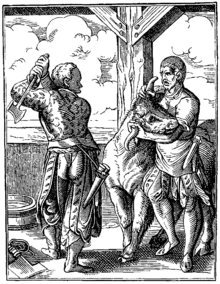
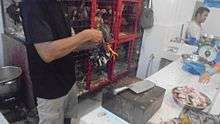
Animal slaughter is the killing of animals, usually referring to killing domestic livestock. In general, the animals would be killed for food; however, they might also be slaughtered for other reasons such as being diseased and unsuitable for consumption. The slaughter involves some initial cutting, opening the major body cavities to remove the entrails and offal but usually leaving the carcass in one piece. Such dressing can be done by hunters in the field (field dressing of game) or in a slaughterhouse. Later, the carcass is usually butchered into smaller cuts.
The animals most commonly slaughtered for food are cattle and water buffalo for beef and veal, sheep for lamb and mutton, goats for goat meat , pigs for pork, deer for venison, horses for horse meat, poultry (mainly chickens, turkeys and ducks), insects (a commercial species is the house cricket), and increasingly, fish in the aquaculture industry (fish farming).
Modern history
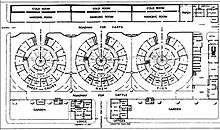
The use of a sharpened blade for the slaughtering of livestock has been practiced throughout history. Prior to the development of electric stunning equipment, some species were killed by simply striking them with a blunt instrument, sometimes followed by exsanguination with a knife.
The belief that this was unnecessarily cruel and painful to the animal eventually led to the adoption of specific stunning and slaughter methods in many countries. One of the first campaigners on the matter was the eminent physician, Benjamin Ward Richardson, who spent many years of his later working life developing more humane methods of slaughter as a result of attempting to discover and adapt substances capable of producing general or local anaesthesia to relieve pain in people. As early as 1853, he designed a chamber that could kill animals by gassing them. He also founded the Model Abattoir Society in 1882 to investigate and campaign for humane methods of slaughter and experimented with the use of electric current at the Royal Polytechnic Institution.[1]
The development of stunning technologies occurred largely in the first half of the twentieth century. In 1911, the Council of Justice to Animals (later the Humane Slaughter Association, or HSA) was established in England to improve the slaughter of livestock.[2] In the early 1920s, the HSA introduced and demonstrated a mechanical stunner, which led to the adoption of humane stunning by many local authorities.[3]
The HSA went on to play a key role in the passage of the Slaughter of Animals Act 1933. This made the mechanical stunning of cows and electrical stunning of pigs compulsory, with the exception of Jewish and Muslim meat.[3][4] Modern methods, such as the captive bolt pistol and electric tongs were required, and the act's wording specifically outlawed the poleaxe. The period was marked by the development of various innovations in slaughterhouse technologies, not all of them particularly long-lasting.
Methods
Many countries have adopted the principle of a two-stage process for the non-ritual slaughter of animals. This is to ensure a rapid death with minimal suffering. The first stage of the process, usually called stunning, renders the animal unconscious, and thus not susceptible to pain, but not necessarily dead. In the second stage, the animal is killed. Countries differ in the methods which have been legalized for different species or different ages, some regulations being governmental, others being religious.
Stunning
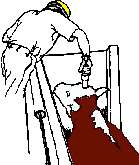
Various methods are used to render an animal unconscious during animal slaughter.
- Electrical (stunning or slaughtering with electric current known as electronarcosis)
- This method is used for swine, sheep, calves, cattle, and goats. Current is applied either across the brain or the heart to render the animal unconscious before being killed. In industrial slaughterhouses, chickens are killed prior to scalding by being passed through an electrified water-bath while shackled.[5]
- Gaseous (Carbon dioxide)
- This method can be used for sheep, calves and swine. The animal is asphyxiated by the use of CO2 gas before being killed. In several countries, CO2 stunning is mainly used on pigs. A number of pigs enter a chamber which is then sealed and filled with 80% to 90% CO2 in air. The pigs lose consciousness within 13 to 30 seconds. Research has produced conflicting results, with some showing pigs tolerate CO2 stunning and others showing they do not.[6][7][8] Nitrogen has been used to induce unconsciousness, often in conjunction with CO2. Domestic turkeys are averse to high concentrations of CO2 (72% CO2 in air) but not low concentrations (a mixture of 30% CO2 and 60% argon in air with 3% residual oxygen).[9]
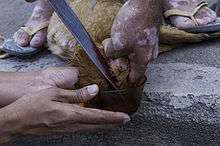
- Mechanical (Captive bolt pistol)
- This method can be used for sheep, swine, goats, calves, cattle, horses, mules, and other equines. A captive bolt pistol is applied to the head of the animal to quickly render them unconscious before being killed. There are three types of captive bolt pistols, penetrating, non-penetrating and free bolt. The use of penetrating captive bolts has largely been discontinued in commercial situations to minimize the risk of transmission of disease when parts of the brain enter the bloodstream.
- Mechanical (gunshot/free bullet)
- This method can be used for cattle, calves, sheep, swine, goats, horses, mules, and other equines. A conventional firearm is used to fire a bullet into the brain of the animal to render the animal quickly unconscious (and presumably dead). A second method may be used (e.g. drug administration) to ensure the animal is dead.
Killing
National laws
Europe
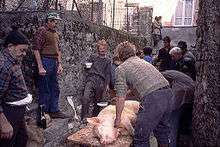
The measures for sanitary checks, animal welfare protection and slaughtering procedures are harmonised throughout the European Union, and detailed by the European Commissions' regulations CE 853/2004, 854/2004 and 1099/2009.
Canada
In Canada, the handling and slaughter of food animals is a shared responsibility of the Canadian Food Inspection Agency (CFIA), industry, stakeholders, transporters, operators and every person who handles live animals. Canadian law requires that all federally registered slaughter establishments ensure that all species of food animals are handled and slaughtered humanely. The CFIA verifies that federal slaughter establishments are compliant with the Meat Inspection Regulations. The CFIA's humane slaughter requirements take effect when the animals arrive at the federally registered slaughter establishment. Industry is required to comply with the Meat Inspection Regulations for all animals under their care. The Meat Inspection Regulations define the conditions for the humane slaughter of all species of food animals in federally registered establishments. Some of the provisions contained in the regulations include:
- guidelines and procedures for the proper unloading, holding and movement of animals in slaughter facilities
- requirements for the segregation and handling of sick or injured animals
- requirements for the humane slaughter of food animals[12]
United Kingdom
Animal slaughter in the UK is governed under both its own laws and EU law regarding slaughter. The Department for Environment, Food and Rural Affairs (Defra) is the main governing body responsible for legislation and codes of practice covering animal slaughter in the UK.
In the UK the methods of slaughter are largely the same as those used in the United States with some differences. The use of captive bolt equipment and electrical stunning are approved methods of stunning sheep, goats, cattle and calves for consumption[11]- with the use of gas reserved for swine.[13]
United States
In the United States, the United States Department of Agriculture (USDA) specifies the approved methods of livestock slaughter:[14]
Each of these methods is outlined in detail, and the regulations require that inspectors identify operations which cause "undue" "excitement and discomfort" of animals.
In 1958, the law that is enforced today by the USDA Food Safety and Inspection Service (FSIS) was passed as the Humane Slaughter Act of 1978. This Act requires the proper treatment and humane handling of all food animals slaughtered in USDA inspected slaughter plants. It does not apply to chickens or other birds.[15]
4D Meat
Meat from animals which are dead, diseased, disabled or dying (4-D meat) on the arrival at the slaughterhouse is often salvaged for rendering[16], and used by a wide range of industries including pet food manufacturers, zoos, greyhound kennels, and mink ranches. [17]
The U.S. Code (Title 21, Chapter 12, Subchapter II, § 644) [18] Regulates transactions, transportation, or importation of 4–D animals to prevent use as human food:
"No person, firm, or corporation engaged in the business of buying, selling, or transporting in commerce, or importing, dead, dying, disabled, or diseased animals, or any parts of the carcasses of any animals that died otherwise than by slaughter, shall buy, sell, transport, offer for sale or transportation, or receive for transportation, in commerce, or import, any dead, dying, disabled, or diseased cattle, sheep, swine, goats, horses, mules or other equines, or parts of the carcasses of any such animals that died otherwise than by slaughter, unless such transaction, transportation or importation is made in accordance with such regulations as the Secretary may prescribe to assure that such animals, or the unwholesome parts or products thereof, will be prevented from being used for human food purposes."
The 2004 report to US Congress titled “Animal Rendering: Economics and Policy” [19], available in the library of Congressional Research Service, in the ‘Introduction’ paragraph explains Renderers in the US and Canada convert dead animals and other waste material into sellable products:
“Renderers convert dead animals and animal parts that otherwise would require disposal into a variety of materials, including edible and inedible tallow and lard and proteins such as meat and bone meal (MBM). These materials in turn are exported or sold to domestic manufacturers of a wide range of industrial and consumer goods such as livestock feed and pet food, soaps, pharmaceuticals, lubricants, plastics, personal care products, and even crayons.”
Although some authors have found health problems associated with the consumption of 4D meat by certain species in its raw form [20] or found it potentially hazardous [21], FDA considers it fit for animal consumption:
"Pet food consisting of material from diseased animals or animals which have died otherwise than by slaughter, which is in violation of 402(a)(5) will not ordinarily be actionable, if it is not otherwise in violation of the law. It will be considered fit for animal consumption."[22]
Religious laws for ritual slaughter
Ritual slaughter is the overarching term accounting for various methods of slaughter used by religions around the world for food production. While keeping religious autonomy, these methods of slaughter, within the United States, are governed by the Humane Slaughter Act and various religion-specific laws, most notably, Shechita and Dhabihah.
Buddhism
Animal slaughter in Buddhism is not accepted . According to the 1st Pancasila (Precept) "I undertake the training rule to avoid killing"; however, in practice animal slaughter commonly takes place in majority Buddhist countries and most Buddhists are not vegetarian. In addition, Buddhist monks must eat all foods given to them, including meat. Some Buddhists interpret killing for food as acceptable.
Shechita – Jewish law for slaughtering animals
Animal slaughter in Judaism falls in accordance to the religious law of Shechita. In preparation, the animal being prepared for slaughter must be considered kosher (fit) before the act of slaughter can commence and consumed. The basic law of the Shechita process requires the rapid and uninterrupted severance of the major vital organs and vessels. They slit the throat, resulting in a quick drop in blood pressure, restricting blood to the brain. This abrupt loss of pressure results in the rapid and irreversible cessation of consciousness and sensibility to pain (a requirement held in high regard by most institutions.)[23]
Dhabihah – Islamic law for slaughtering animals
Animal slaughtering in Islam is in accordance with the Qur’an. To slaughter an animal is to cause it to pass from a living state to a dead state. For the meat to be lawful (Halal) according to Islam, it must come from an animal which is a member of a lawful species and it must be ritually slaughtered, i.e. according to the Law, or the sole code recognized by the group as legitimate. The animal is killed in ways similar to the Jewish ritual with the throat being slit (dabh), resulting in a quick drop in blood pressure, restricting blood to the brain. This abrupt loss of pressure results in the rapid and irreversible cessation of consciousness and sensibility to pain (a requirement held in high regard by most institutions.). The slaughterer must say Bismillah (In the name of Allah/God) before slaughtering the animal.[24] Blood must be drained out of the carcass.[25]
Controversy
There has been controversy over whether or not animals should be slaughtered and over the various methods used. Some people believe sentient beings should not be harmed regardless of the purpose, or that meat production is an insufficient justification for harm. Religious slaughter laws and practices have always been a subject of debate, and the certification and labeling of meat products remain to be standardized. Animal welfare concerns are being addressed to improve slaughter practices by providing more training and new regulations. There are differences between conventional and religious slaughter practices, although both have been criticized on grounds of animal welfare. Concerns about religious slaughter focus on the stress caused during the preparation stages before the slaughtering, pain and distress that may be experienced during and after the neck cutting and the worry of a prolonged period of time of lost brain function during the points between death and preparation if a stunning technique such as electronarcosis is not applied.[26]
Statistics
| Animal | Number |
|---|---|
| Chickens | 58,110,000,000 |
| Domestic ducks | 2,817,000,000 |
| Domestic pigs | 1,383,000,000 |
| Domestic turkeys | 654,000,000 |
| Geese & Guineafowl | 649,000,000 |
| Sheep | 517,000,000 |
| Goats | 430,000,000 |
| Cattle | 296,000,000 |
| Bisons | 24,000,000 |
| Total[28] | 63,635,300,000 |
See also
- Animal euthanasia
- Animal sacrifice
- Carnism
- Controlled-atmosphere killing
- Fish slaughter
- Horse slaughter
- Ike jime, a Japanese method of slaughtering fish
- Meat
- Pet food
- Pig slaughter
- Udhiyyah or Qurbani, the sacrifice of a livestock animal according to Islamic law
- Veganism
References
- ↑

- ↑ "Humane Slaughter Association Newsletter March 2011" (PDF). Humane Slaughter Association. Retrieved 1 July 2014.
- 1 2 "History of the HSA". Humane Slaughter Association. Retrieved 1 July 2014.
- ↑ Leese, Arnold. "The Legalised Cruelty Of Shechita: The Jewish Method Of Cattle-Slaughter". Retrieved 1 July 2014.
- ↑ Mead, edited by G.C. (2004). Poultry meat processing and quality. Cambridge: Woodhead Pub. p. 71. ISBN 978-1-85573-903-1. Retrieved 6 November 2015.
- ↑ "When is carbon dioxide stunning used in abattoirs?". RSPCA. Retrieved June 14, 2013.
- ↑ Jong, E.C., Barnett, J.L. and Hemsworth, P.H., (2000). The aversiveness of carbon dioxide stunning in pigs and a comparison of the CO2 stunner crate vs. the V-restrainer. Applied Animal Behaviour Science, 67: 67-76
- ↑ Raj, A.B.M. and Gregory, N.G., (1995). Welfare implications of the gas stunning of pigs 1. Determination of Aversion to the Initial Inhalation of Carbon Dioxide or Argon. Animal Welfare, Volume 4, Number 4, November 1995, pp. 273-280(8)
- ↑ Raj, M., (1999). Aversive reactions of turkeys to argon, carbon dioxide and a mixture of carbon dioxide and argon. Veterinary Record, 138:592-593 DOI:10.1136/vr.138.24.592
- ↑ "Farmed animal welfare: Slaughter". Department for Environment Food and Rural Affairs. 3 September 2009. Archived from the original on September 26, 2009. Retrieved March 15, 2010.
- 1 2 "Slaughter Red". Hsa.org.uk. Retrieved 2011-10-18.
- ↑ "Humane Handling and Slaughter of Food Animals in Canada". Canadian Food Inspection Agency.
- ↑ "Pig Slaughter". Hsa.org.uk. Retrieved 2011-10-18.
- ↑ "Humane Slaughter of Livestock Regulations (National Citation: 9 C.F.R. 313.1 – 90)". Animal Legal and Historical Center (regulations from USDA). 2007.
- ↑ "Humane Methods of Slaughter Act". National Agricultural Library.
- ↑ "4D meat".
- ↑ Affairs, Office of Regulatory. "Compliance Policy Guides - CPG Sec. 690.500 Uncooked Meat for Animal Food". www.fda.gov.
- ↑ "21 U.S. Code § 644 - Regulation of transactions, transportation, or importation of 4–D animals to prevent use as human food". LII / Legal Information Institute.
- ↑ S., Becker, Geoffrey (17 March 2004). "Animal Rendering: Economics and Policy". Digital Library.
- ↑ https://www.grey2kusa.org/pdf/4-DMeatFactSheet.pdf
- ↑ "Meat-based diets". www.vegepets.info.
- ↑ "FDA Compliance Policy Guide Sec. 690.300 about Canned Pet Food". www.fda.gov. U.S Food and Drug Administration. Retrieved August 1, 2018.
- ↑ Jones, Sam. "Halal, shechita and the politics of animal slaughter". The Guardian.
- ↑ Benkheira, Mohammed (2000). "Artificial death, canonical death: Ritual slaughter in Islam". Food and Foodways. 4. 8 (4): 227–252. doi:10.1080/07409710.2000.9962092.
- ↑ Jones, Sam. "Halal, shechita and the politics of animal slaughter". theguardian.com. The Guardian. Retrieved 2 February 2016.
- ↑ Anil, Haluk. "Religious slaughter: A current controversial animal welfare issue". Animal Frontiers.
- ↑ "Fleischatlas 2014" (PDF). Heinrich-Böll-Stiftung. 8 January 2014. p. 19. Archived from the original (PDF) on 26 July 2017. Retrieved 10 November 2016.
- ↑ Excluding marine animals (fish, marine mammals etc.) and other land animals such as horses, dogs, deer etc. which are slaughtered less frequently.
External links
- Canada Agricultural Products Act R.S., 1985, c. 20 (4th Supp.)
- Humane Slaughter of Livestock Regulations
- Slovak Pig Slaughter and Traditional Sausage Making – article in English with detailed pictures of a Slovak family slaughtering a pig in the traditional style
- Live Counter About Slaughtered Animals Worldwide
| Wikimedia Commons has media related to Slaughtering. |